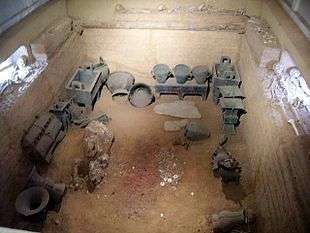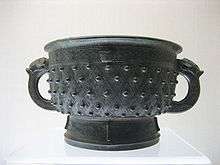Tomb of Fu Hao

The Tomb of Fu Hao (simplified Chinese: 妇好墓; traditional Chinese: 婦好墓; pinyin: Fù Hǎo Mù) is an archaeological site at Yinxu, the ruins of the ancient Shang dynasty capital Yin, within the modern city of Anyang in Henan Province, China. Discovered in 1976, it was identified as the final resting place of the queen and military general Fu Hao, who died about 1200 BCE and was likely the Lady Hao inscribed on oracle bones by king Wu Ding and one of his many wives.[1]
It is to date the only Shang royal tomb found intact with its contents and excavated by archaeologists. The excavation was conducted by the Anyang Working Team of the Archaeological Institute of the Chinese Academy of Social Sciences, and after extensive restoration the tomb was opened to the public in 1999.
Discovery and contents
In 1976 archaeologists probing the area around Yinxu with a long shovel, called a Luoyang shovel, recovered some samples of red lacquer.[2] The burial pit uncovered, officially titled tomb number 5, is a single pit, 5.6 metres by 4 m, just outside the main royal cemetery. The tomb has been dated to around BCE 1200 and identified, from inscriptions on ritual bronzes, to be that of Fu Hao.[3][4]
Her tomb, one of the smaller tombs, is one of the best-preserved Shang dynasty royal tombs and the only one not to have been looted before excavation.[1] Inside the pit was evidence of a wooden chamber 5 meters long, 3.5 m wide and 1.3 m high containing a lacquered wooden coffin that has since completely rotted away.[5]
The floor level housed the royal corpse and most of the utensils and implements buried with her. Rare Jade artifacts, such as those of the Liangzhu culture, were probably collected by Fu Hao as antiques and while some of the bronze artifacts were probably used by the lady and her household others inscribed with her posthumous name of Mu Xin were undoubtedly cast as grave goods.[6] The artifacts unearthed within the grave consisted of:
- 755 jade objects (including Longshan, Liangzhu, Hongshan and Shijiahe cultural artifacts)[7]
- 564 bone objects (including 500 hairpins and 20 arrowheads)
- 468 bronze objects, including over 200 ritual bronze vessels,[8] 130 weapons, 23 bells, 27 knives, 4 mirrors, and 4 tiger statues.[9]
- 63 stone objects
- 11 pottery objects
- 5 ivory objects
- 6,900 cowry shells (used as currency during the Shang dynasty)
Below the corpse was a small pit holding the remains of six sacrificial dogs, and along the edge lay the skeletons of 16 human slaves, evidence of human sacrifice.[1]
There is also evidence above ground of a structure built over the tomb that probably served as an ancestral hall for holding memorial ceremonies; this has since been restored.[10]
By connecting the jade artifact in the tomb of Fu Hao to much earlier artifact through stylistic and technical analysis,the archaeological context has identify for us an early collector,a woman who gathered about her artifacts of a much earlier period.[11]
See also
- Tomb of Marquis Yi of Zeng, from some 800 years later, the other major royal tomb found intact from this period in China.
References
| Wikimedia Commons has media related to Tomb of Fu Hao. |
- 1 2 3 Ebrey, Patricia (2006). The Cambridge Illustrated History of China. Cambridge University Press. pp. 26–27. ISBN 0-521-43519-6.
- ↑ "An Yang, ancient capital of the Shang dynasty". China Central Television. Retrieved August 6, 2007.
- ↑ "The Tomb of Lady Fu Hao" (PDF). British Museum. Retrieved August 4, 2007.
- ↑ Keightley, David N. "Art, Ancestors, and the Origins of Writing in China," Representations (Number 56, Special Issue: The New Erudition, 1996): 68–95. Page 76.
- ↑ Buckley Ebrey, Patricia. "Shang Tomb of Fu Hao". A Visual Sourcebook of Chinese Civilization. University of Washington. Retrieved August 4, 2007.
- ↑ "Excavations at the Tomb of Fu Hao". Teaching the Golden Age of Chinese Archeology. National Gallery of Art. Retrieved August 4, 2007.
- ↑ Buckley Ebrey, Patricia. "Jade from Fu Hao's Tomb". A Visual Sourcebook of Chinese Civilization. University of Washington. Retrieved August 4, 2007.
- ↑ Rawson, Jessica (ed). The British Museum Book of Chinese Art, p. 33, 2007 (2nd edn), British Museum Press, ISBN 9780714124469
- ↑ Buckley Ebrey, Patricia. "Bronzes from Fu Hao's Tomb". A Visual Sourcebook of Chinese Civilization. University of Washington. Retrieved August 4, 2007.
- ↑ "Lady Hao's Tomb in the Yin Ruins". The Garden Museum of Yin Ruins.
Lady Hao's Tomb was a tomb of the royal family of the Yin Dynasty, which was excavated by Anyang Working Team of the Archaeological Institute of the Chinese Social Science Academy in 1976. There was a house foundation remained from the Yin Dynasty on the tomb, which was restored to be the Memorial Hall for Lady Hao during the construction of the garden museum. The coffin chamber of the tomb under the house foundation was in the shape of a small shaft with many kinds of funerary objects buried in 7 layers. There were over 1,900 pieces of objects unearthed from the tomb, including bronze vessels, jade objects, gem objects, bone implements, potteries and so on. In addition, there were over 6,880 cowry-shells as well. The coffin chamber of Lady Hao's tomb was restored in 1999. According to the epigraphs on the bronze vessels and the shapes of the objects and referring to the records concerned in the oracular inscriptions, the occupant of the tomb should be the concubine Lady Hao if the King Wuding of the Yin Dynasty. Lady Hao was the earliest woman general in China, died in the period of Wuding and was given a name of temple as Xin after her death. The discovery of Lady Hao's tomb is of important value to the research of politics, economy, culture and art, small states around, rural system, dating of the bronze vessels, ancient science and technology and so on of the Yin dynasty.
- ↑ Whose Culture?: The Promise of Museums and the Debate over Antiquities. Retrieved 2014-02-23.
External links
- Website on the tomb
- 10 minute documentary feature, part 1 of 7
